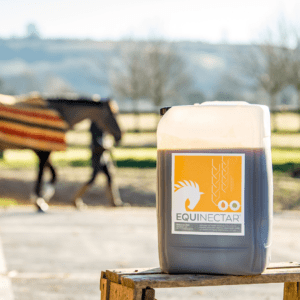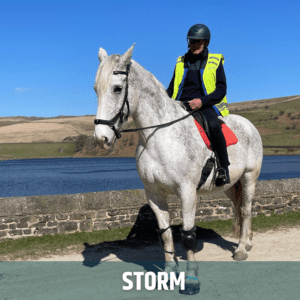Colic in horses
What is colic?
The term “colic” is used to describe an indication of abdominal (belly) pain, which in horses is typically brought on by gastrointestinal disturbances. Signs of colic symptoms can be mild to severe, but the underlying cause is not always related to the severity of the signs; and critical (life-threatening) causes can present as anything from grumbling pain to a horse so painful it will not stand for a few moments. Similarly severe pain can be seen in horses that can be successfully managed with medical treatment. The vast majority of cases of colic can be managed with medical treatment, with less than 10% requiring some form of surgery, However even those requiring medical treatment may need hospitalisation in order to treat the cause successfully.
The prognosis for colic has improved over the years, due to a better understanding of its causes, better diagnostics and improvements in surgery and anaesthesia. However colic can be expensive to manage, and in some cases the cause is not amenable to surgery. While many horses undergoing colic surgery do well in the long run, there are some important complications that you should consider. One of the most crucial aspects that leads to a positive prognosis in horses requiring surgery is an early diagnosis of the cause, leading to prompt surgical intervention.
What are the signs of colic in horses?
In mild cases:
- Lip curling.
- Flank watching.
- Restlessness.
- Pawing the ground.
- Mild sweating, especially around the flank
In moderate cases:
- Frequent posturing, as though to urinate
- Lying down and getting back up.
- Lying on their side for long periods.
In severe cases:
- Violent rolling.
- Sweating.
- Rapid breathing.
- Injuries to body and face from rolling and thrashing around.
To read more: https://www.liverpool.ac.uk/equine/common-conditions/colic/what-is-colic/
What causes colic pain in horses?
There are many potential causes of colic, and it is important to remember that colic itself is not a disease, it is just the signs a horse shows when it has abdominal pain. In many cases, the signs resolve without ever knowing a specific cause, but the reasons for the pain are either
- Stretching of the intestine due to a build up of gas or feed material
- Displacement or twisting of the intestine
- Occlusion of the blood supply to the gut
- Spasms (cramping) of the intestines
Occasionally horses will develop colic from pain of other organs in the body, sometimes referred to as ‘false colic’. This could be due to kidney, liver or other problems. Horses that tie up very badly can sometimes show the same signs as a horse with colic.
Types of colic
Impactions
Impaction of food material in different regions of the intestines leads to a blockage, and then distension of the intestine. Most impactions happen in the large colon and are very easy to diagnose by a vet.This location is common because there is a narrowing of the intestine at the pelvic flexure. Occasionally impactions can occur elsewhere, including the stomach and small colon.
Impactions can result from a variety of causes including
- Insufficiently chewed coarse feed (possible related to dental disease)
- Lack of water intake, worsened by dehydration, as seen in horses that don’t drink in very cold weather
- Reduced motility of the intestines that can occur when horses are stabled and not kept active.
- An intestinal obstruction from other objects
Horses with impactions frequently experience mild pain and stop eating. They might not get significantly worse for a few days, but occasionally present with very severe pain. Continuing to feed horses with impactions can worsen the problem as the food cannot pass.
Tympanic or gassy colic
The microbes of the colon are essential for breaking down plant materials. But excessive sugar or rapid dietary changes can disrupt the balance of bacteria leading to rapid fermentation and the production of gas. The gas stretches the gut wall causing pain, and may also create the situation where the colon can become displaced. Horses with tympanic colic will appear distended in the flank area when you stand behind them, but usually have mild to moderate pain.
Colon displacements
The horse’s colon is a massive structure, containing many litres of food and liquid. However it is only fixed in position by its attachment to other parts of the intestine, and can therefore move. When this movement leads to displacement, it either rotates around its long axis, flipping forwards, or more seriously twists around the short axis (torsion). This often occurs with a build up of gas, such that it cannot easily revert to its normal position. Many displacements can be managed with medical management, time and patience, however those that twist (torsions) are the most serious and life threatening of all causes of colic. These require immediate surgery to restore the normal position and maintain blood flow to the colon. If left too long, the intestines can be starved of oxygen leading to the toxins crossing into the blood.
Intestinal strangulation
As well as colon torsions, disruption to the blood supply can occur when fatty tumours (lipomas) wrap around the intestine (usually the small intestine), obstructing blood flow. Again, this can be life threatening and leads to severe pain. If not corrected rapidly, horses with this type of colic develop severe fluid overload of the stomach, which occasionally ruptures. A complication that can not be repaired.
Sand colic
Horses that graze on pastures with a sandy soil can end up taking in considerable amounts of sand. This sits in the most dependent part of a horse’s colon, causing both stretching of the intestinal lining, and abrasion by the movement of sand inside the horse’s guts. Once there, the weight of the sand means the horse is not usually able to pass it. Ensuring horses have long enough grass to prevent intake of sand is important to reduce these risks, although some treatments may be necessary.
A vet’s view
Dr Mark Bowen shared his view:
“Although colic can strike without warning and have catastrophic consequences, there are things that horse owners can do to limit the risks of some forms of colic. An effective strategic worming program based on faecal worm accounts, and the judicious use of wormers, reducing the impact of sandy soils, ensuring access to clean water, and careful management of changes in diet may reduce the occurrence of colic.
Managing the health of the horse’s intestinal microbiome is one of the tools that I use when managing horses with recurrent colic and EquiNectar plays an important role in preventing excessive fermentation that can contribute to several types of colic”
A nutritionist’s view
Lorraine Hughes offers her experience:
“Nutrition plays an essential role in the cause of colic. The type of forage to the amount of turnout can all lead to colic. Impaction colics are often associated with coarse forages, high-concentrate/low-fibre diets and sudden changes from turnout to stall confinement. Poor dentition can also lead to colic due to the reduced capacity of mastication of the food. Obesity and geriatric horses are at risk of lipomas linked to small intestine strangulation. Sudden changes in diet can also cause colics, including a new batch of concentrated feed or even something as simple as a bale of conserved forage from a different field to the usual conserved forage. Changes to the diet, including new batches of feed, should be made gradually to help prevent colics. The hygienic quality of the conserved forage can all significantly increase the risk of colics. Concentrate feeding and legume forage, alfalfa or lucerne, are associated with duodenitis-proximal-jejunitis. Legumes are also linked to colon obstruction with enteroliths.
To help prevent colic, turn horses out as much as possible due to the gastrointestinal tract being designed to receive a constant supply of forages, with horses generally grazing for between 8-14 hours per day when allowed free access to pasture and conserved forage. Ensuring there is always a supply of clean, fresh water also helps prevent against colic and in cold weather providing warm water will help encourage horses to drink. Reducing the amount of starch and grains within the diet will also help prevent against colic and ensure any conserved forages fed are of good quality and free from moulds or excessive dust.”
Colic prevention
The following advice is from the Blue Cross:
- A constant supply of fresh water
- Small and frequent feeds of concentrates if necessary. Only use hard feed as a supplement to the grazing and high fibre food available to the horse.
- Plan a diet consisting of high fibre content, using hay or other high fibre equivalent feeds. A ratio of at least 60 per cent hay or equivalent.
- Ensure the feed is of good quality and is not mouldy, and has no hidden hazards such as baling twine/plastic
- Set a regular exercise programme, ensuring that the horse is fit for the work needed. Do not suddenly overexert your horse.
- Make any changes to exercise or feed slowly
- Allow as much turn out in a paddock as possible
- Have regular dental checks as poorly chewed food increases the risk of a blockage in the intestine
- Ration lush spring grass, treating it as a change of diet to the horse
- Wherever possible, avoid your horse grazing heavily sanded pasture
- Ensure the worm control programme is kept up to date as recommended by your vet
- Have a regular daily routine and make changes gradually
To read more: https://www.bluecross.org.uk/advice/horse/horse-colic-prevention-and-management
What should you do if you suspect colic?
The following is advice from the University of Liverpool Equine Hospital:
Colic is a potentially life-threatening disease. If a horse displays moderate or severe signs it will require emergency veterinary attention, occasionally hospitalisation. If your horse displays mild symptoms of colic, try walking them around for no more than ten minutes. If symptoms persist for more than 30 minutes or are more severe in nature, call your vet immediately.
To read more: https://www.liverpool.ac.uk/equine/common-conditions/colic/what-is-colic/
Contributors:
Dr Mark Bowen,
BVetMed MMedSci(MedEd) PhD CertVA CertEM(IntMed) DipACVIM-LAIM DipECEIM PFHEA FRCVS

Mark is an internationally recognised veterinary specialist and clinical scientist. His career has seen him obtain recognition in a large range of disciplines.
He is an RCVS recognised specialist in equine internal medicine, a EBVS European specialist in Veterinary Sports Medicine and Rehabilitation and an ABVS American Specialist in Large Animal Internal Medicine.
Mark spent a career in clinical academia being promoted all the way to Professor, before building his own clinical and educational consultancy business in 2021, working for a range of businesses including The European Board of Veterinary Specialisation (EBVS) and Veterinary Continuous Education in Europe (VetCEE). He is author of many publications, including the development of consensus guidelines for the management of gastric disease, obesity and pain in horses.
Lorraine Hughes
MSc, BSc, PhD candidate

Lorraine completed her undergraduate degree in equine sports science. She received an MSc in equine performance health and welfare from Nottingham Trent University, where she focused on equine gastric ulcer syndrome (EGUS).
Lorraine is the owner/director of Equineus Ltd, an equine nutrition and welfare consultancy. She is a nutritionist with an equine physiology background so is able to apply holistic strategies to horse welfare.
She is currently in her first year of a PhD on EGUS.





